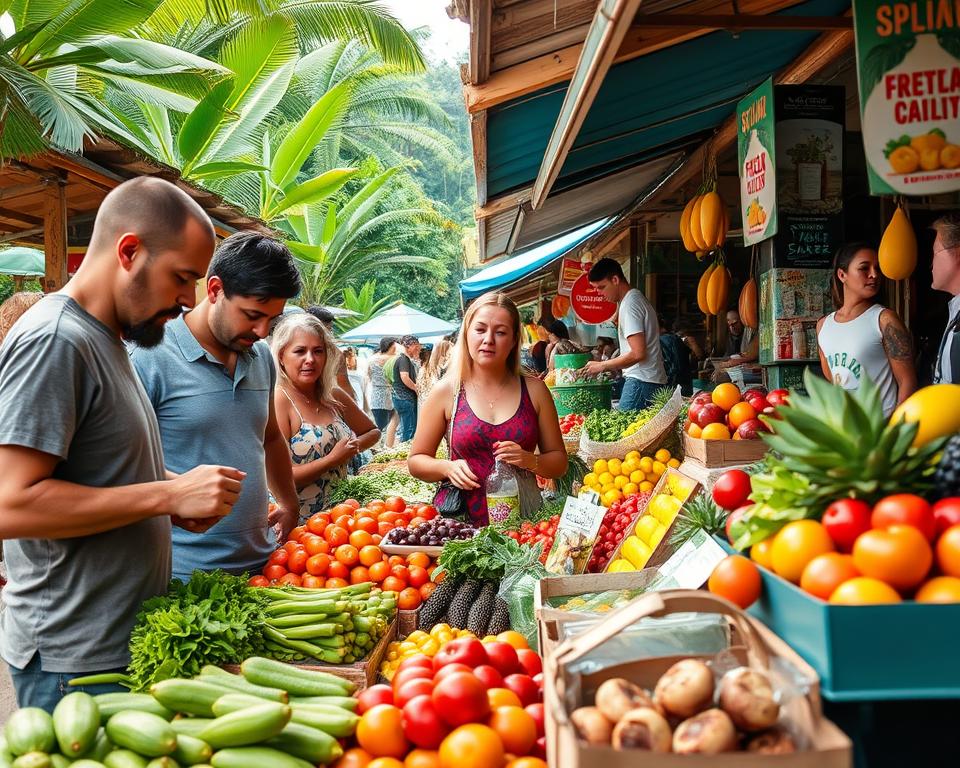Costa Rica Food: Why Are Prices High?
Why does food cost so much in a country known for its stunning beauty and lively culture? Many people find the high food prices in Costa Rica surprising. You might think a tropical paradise would have cheap, fresh food. But, the reality is shaped by economic factors, government policies, and challenges in local production.
Looking closer at Costa Rica’s agricultural and economic systems helps us understand why food is expensive there.
Key Takeaways
- The high cost of food in Costa Rica is largely due to government agricultural protectionism.
- High tariffs on imports like rice and milk contribute significantly to inflated food prices.
- Expensive food impacts both locals and tourists, altering their dining budgets.
- The average food price index has risen by 33.5% over the past five years, indicating a notable increase in living costs.
- Subsidy programs like “Plan Proteger” aim to assist low-income families in managing food expenses.
Understanding the High Cost of Food in Costa Rica
The cost of food in Costa Rica is high due to several factors. These include economic conditions, the need for imports, and challenges in local agriculture. The average monthly income varies a lot, with the top 16% earning about $2,248 and 65% earning $500 or less. This affects how people buy food.
Most of the food in Costa Rica comes from imports, making prices higher than in the US or Europe. Import taxes and tariffs add to the cost. Local food is often fresher but has seen prices go up by 2 to 3 times, making it hard for many to buy basic items. For instance, a traditional casado meal costs between $6 and $11 in tourist areas, showing the economic impact on food prices.
Even local beef and fish have seen price increases, with quality beef around $10 per pound. With over 20% living below the poverty line, it’s crucial to understand the food budget challenges. This situation makes food prices not just about market conditions but also about social issues.
Economic Factors Contributing to Food Prices
Many economic factors make food prices high in Costa Rica. Inflation is a big one, cutting down on what families can buy. This makes it hard for many to get the food they need.
The cost of basic groceries has gone up a lot. This shows how tough inflation is on people’s wallets.
Inflation and Its Impact on Purchasing Power
Living costs have jumped because of inflation. In Costa Rica, people spend about 30% of their income on food and drinks. For those earning just US$100 a month, it’s a big challenge to get by.
Other countries spend 25 to 45 percent of their income on food. This shows how tough it is in Costa Rica.
Fluctuations in the U.S. Dollar and Import Costs
Changes in the U.S. dollar affect import costs in Costa Rica. Since many food items come from the U.S., the dollar’s value changes food prices. Higher import costs make it harder for people to buy basic foods.
Food and agriculture are big parts of Costa Rica’s economy. This shows how these economic factors link together to affect food costs.

Government Policies and Their Effects on Food Pricing
Government policies greatly affect food prices in Costa Rica. They use high tariffs and subsidies, which change the cost of basic foods. These policies help explain why food prices are rising.
High Tariffs and Import Duties
High tariffs in Costa Rica protect local industries but make food more expensive for consumers. Duties on things like rice and milk make imports cost more than local products. This limits competition, leading to higher prices for everyone.
Two companies control 82% of the rice market, limiting choices for buyers. The country also depends a lot on imports for animal feed. This means higher import prices lead to higher meat and egg prices.
Price Controls and Subsidies for Basic Food Items
The Costa Rican government tries to help citizens by controlling prices and giving subsidies for basic foods. Items like rice, beans, and eggs are still affordable thanks to this. But, not everyone agrees that these policies work well.
Some say these actions can harm supply chains and market balance. While the goal is to help families, experts debate if these policies are sustainable over time.
Why is Costa Rica Food Expensive: Local Production Challenges
The high cost of food in Costa Rica comes from several challenges. Limited land and high labor costs make it hard for farmers to keep prices low. These issues make food more expensive for both locals and tourists.
Limited Agricultural Land and High Labor Costs
Costa Rica faces challenges due to limited farmland. As cities grow, farmland shrinks, making it tough for farmers to grow many crops. High labor costs also add pressure, making it hard for farmers to stay profitable. This leads to higher food prices for everyone.
Sustainable Practices and Their Financial Implications
Many farmers in Costa Rica choose sustainable methods, even if they’re costly upfront. These methods are key for the long-term health of agriculture but increase prices now. Finding ways to make sustainable farming affordable is crucial.
For those interested in investing in Costa Rican agriculture, GAP Real Estate offers great advice. They focus on clear information and local knowledge to help with tough decisions.
Understanding the challenges in local food production shows the balance between being sustainable and keeping costs low. Exploring the work of companies like Grupo Gap LLC SRL can offer insights into these issues.
The Role of Transportation and Logistics in Food Costs
Transportation and logistics play a big part in making food expensive in Costa Rica. The country’s mountains make it hard to move food, especially to rural areas. This makes food more costly for everyone.
Transportation Costs and Geographic Challenges
Logistics and geography make food prices in Costa Rica go up. Here are some reasons why:
- Increased road maintenance needs because of tough landscapes.
- More fuel used because of the steep hills.
- Longer times to reach rural areas.
Bad roads and poor transport networks make getting food to people hard. This means higher prices for us. The World Bank says logistics costs in Latin America and the Caribbean are 16 to 26% of GDP. That’s more than the OECD average of about 9%.
Infrastructure Limitations Affecting Distribution
Costa Rica’s infrastructure makes things harder. Logistics can be over 50% of what consumers pay for goods. This is because of handling, storage, and getting the goods to us.
Imported food is a big part of what we eat. But, the country’s infrastructure can’t handle it well. This leads to higher costs at every step, from the port to our tables.

Impact of Tourism on Food Prices in Costa Rica
Tourism in Costa Rica greatly affects food prices. Tourists look for unique foods, which changes what locals and visitors pay. This leads to higher prices for tourists, making life harder for locals.
Tourist-Centric Pricing vs. Local Expenses
In Costa Rica, daily food costs range from $48 to $69 per person. This includes meals, snacks, and drinks. Prices vary a lot depending on where you eat.
Local sodas offer meals for $10 in tourist areas, but fine dining can cost up to $30 for the same meal. This affects both tourists and locals, who pay more because of tourism.
How the Tourism Industry Influences Local Markets
Tourism changes local markets by making prices go up. A casado meal costs $5 to $8 in local spots but $12 to $20 in tourist areas. Knowing this helps with budgeting for trips.
Government data shows that food and drink in tourism costs about as much as lodging. This shows how big of an effect tourism has on food prices.

Comparison with Other Central American Countries
Looking at the food prices in Costa Rica shows big differences with other Central American countries. Costa Rica has higher food costs, but this shows it has a better quality of life. The local economy and focus on the environment play a big part in this.
This helps people moving there understand their budget better.
Quality of Life vs. Cost of Living Analysis
In Costa Rica, eating out can cost between $5 and $10 at local spots. Casual dining is $10 to $20 per person. But, high-end places can be $30 to $50 or more.
This shows how food prices match the living standards. Even with higher costs, many people value the better healthcare, education, and infrastructure.
Consumer Experiences in Neighboring Countries
Other Central American countries have different consumer experiences. For example, a family in Costa Rica might spend $200 a week on groceries. This is more than in other places.
This shows how people’s choices and economic situations vary. Yet, the quality of life in Costa Rica often makes the higher costs worth it. The country offers many amenities and services that make life better.
Conclusion
Costa Rica’s high food costs come from many complex factors. These include economic conditions, government policies, and challenges in local production. The country imports over 50% of its food, making prices go up, especially for local versus imported items.
A pound of imported potatoes can be up to 300% more expensive than those grown locally. This shows how big the price difference can be.
The COVID-19 pandemic made things worse by increasing transport costs and import taxes. Currency changes also added to the problem. This makes it hard for people to find affordable food in Costa Rica.
Local farming methods like agroforestry could help lower costs and make farming more sustainable. But for now, high import duties on meat and dairy products keep affecting the economy.
To understand food prices in Costa Rica, you need to know about its unique geography and economy. This helps locals and visitors make better choices when buying food. Finding ways to tackle these issues is crucial for a stronger, more sustainable food system in Costa Rica.
Source Links
- https://crie.cr/why-is-food-so-expensive-in-costa-rica-2/
- https://crie.cr/why-is-food-so-expensive-in-costa-rica/
- https://medium.com/@ayeebalde/4-reasons-why-costa-rica-is-so-expensive-2cfda1bc15fb
- https://ticotimes.net/2024/06/30/debunking-the-myth-of-costa-ricas-exorbitant-cost-of-living
- https://costa-rica-guide.com/practical/budget/how-much-does-food-cost/
- https://foodtank.com/news/2015/04/high-food-prices-and-obesity-in-costa-rica/
- https://www.fao.org/4/Y4632E/y4632e0a.htm
- https://www.liveincostarica.com/blog/2018/06/the-real-cost-of-living-in-costa-rica-2.html
- https://qcostarica.com/why-did-costa-rica-have-one-of-the-highest-food-price-hikes/
- https://www.makecostaricahome.com/post/cost-of-living-in-costa-rica-is-costa-rica-expensive
- https://costaricalearn.com/why-is-the-cost-of-living-in-costa-rica-so-high-what-happened-to-living-in-paradise/
- http://www.rfmmeeting.org/2009_-_Logistics_Transport_and_Food_Prices_in_LAC.pdf
- https://ideas.repec.org/p/idb/brikps/2541.html
- https://www.ers.usda.gov/webdocs/publications/45165/41077_err160.pdf
- https://crie.cr/food-costs-in-costa-rica/
- https://crie.cr/is-food-expensive-in-costa-rica/
- https://tulutravel.net/costa-rica-travel-guide/cost-of-living-in-costa-rica/
- https://mytanfeet.com/expenses-wrap-up/cost-of-traveling-in-costa-rica/
- https://discoveny.com/what-do-things-cost-in-costa-rica/
- https://www.gaprealestate.com/why-is-costa-rica-food-expensive/
- https://tucandream.com/is-it-expensive-to-live-in-costa-rica/




